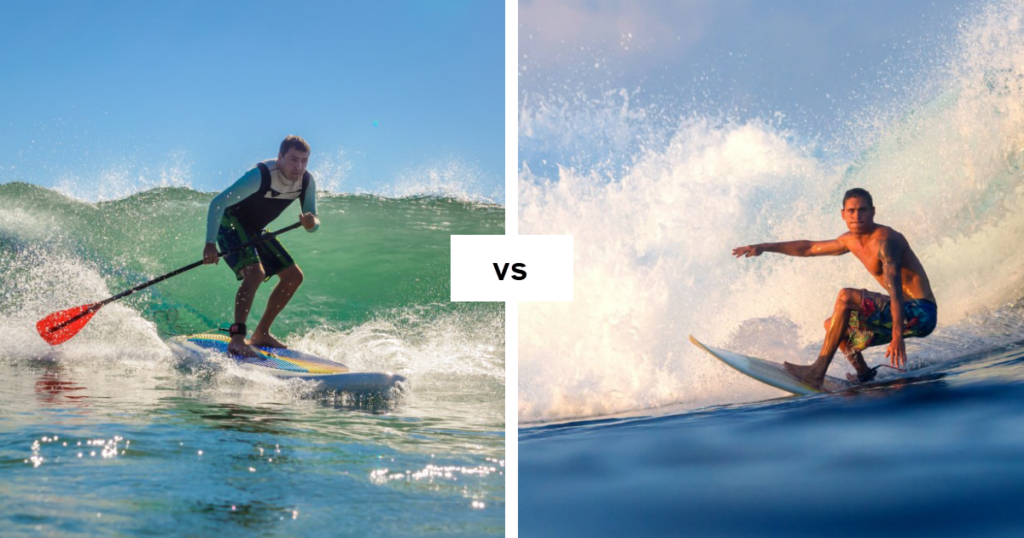Are you considering surfing as a hobby? If you are new to the sport, you may come across different types of boards. In fact, some people even enjoy surfing on a stand up paddleboard instead of a traditional surfboard. But is this a good idea, or are you cheating yourself of the true surfing experience? Find out today in my SUP vs surfboard comparison.
Today, I’ll dig in with a SUP vs surfboard comparison to help you understand the pros and cons of each type of board for catching rad waves.
Here’s a general overview of what you’ll learn.
- SUPs are best for beginners because they offer better stability and require less skill to enjoy in the surf.
- Surfboards are best for skilled surfers because they offer superior maneuverability and on a surfboard you can carve through powerful waves with confidence and precision.
Over the years, SUPs have become increasingly popular in the surfing community. Although surfboards look similar to SUP, they have different features and designs, allowing them to perform differently in water.
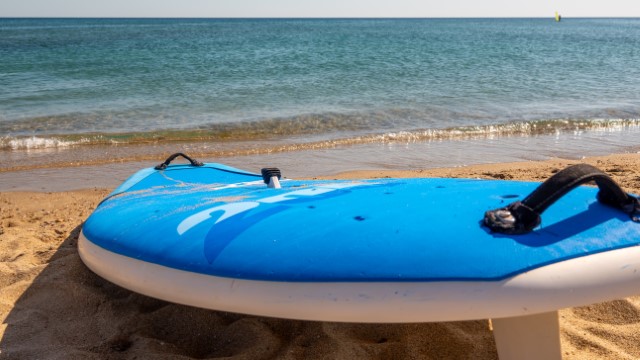
I will explore the the similarities and differences between both boards in this article, to help you choose the best one for you.
Key Differences Between Using a SUP and a Surfboard
| SUP BOARDS | SURFBOARDS |
|---|---|
| Longer, thicker, and broader boards. | Shorter, narrower, and thinner boards. |
| SUP boards are versatile and used for different functions and activities. | Limited to only surfing activities. |
| They use a paddle to move through the water. | You rely on your hands to paddle and catch waves. |
| Higher floating capability. | Lower floating capability. |
| It requires limited skills and is excellent for beginners. | Surfboards have a longer learning curve. |
| They have a rounded nose and square tail. SUP boards also have a flatter rocker and a more rounded rail design. | Surfboards have a pointed nose and a pintail. Likewise, surfboards have a tapered rocker and thinner rail designs. |
| Users have a paddle and wear a safety leash, floatation devices, and a wetsuit. | Users use the same equipment except for the paddle. |
| Fiberglass, carbon fiber, wood, plastic, or inflatable PVC make SUP boards. | Fiberglass, carbon fiber, wood, and plastic, make the boards, excluding inflatable PVC. |
| Ideal for surfing small to medium waves. | Surfboards ride steeper and more powerful waves. |
Features Which Differ: Surfboard vs SUP
A standup paddleboard (SUP) is a water glide craft that combines surfing and paddling. Riders use a long stable board to stand and a paddle to propel themselves along the water.
Though SUP sports might seem relatively new, Hawaii and Peru have practiced standup paddling for hundreds of years on their shores.
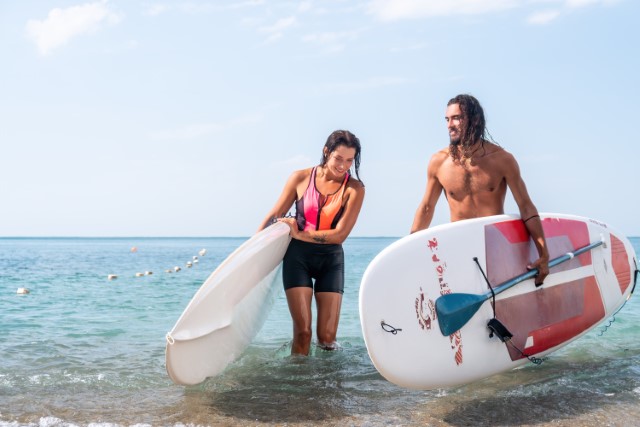
On the other hand, surfboards are planks made from buoyant material for riding waves. However, unlike SUPs, surfers use their hands to paddle and propel themselves to catch waves.
Additionally, shorter boards allow you to paddle using their legs.
Simply put, manufacturers designed paddleboards to give riders better stability when standing, paddling, or doing other water activities. On the other hand, the sole purpose of surfboards is to catch and surf waves.
SUP Surfing boards offer a better experience than a traditional stand up paddle board, but they still can’t match the feel and precision of a surfboard.
Differences Between Surfboards & Stand Up Paddleboards
There are some noticeable differences between surfboards and stand-up paddleboards (SUPs). I’ll go into them in detail below.
1. Board Size
Paddleboards provide better stability at low speeds or during paddling. The boards are thicker, longer, and wider to enhance stability and accommodate the rider’s weight without sinking.
Additionally, better board stability means that riders can take on other water activities like standing, yoga, and even taking on more weight, like children or pets, on your exploration.
Surfboards, conversely, have thinner, narrow, and shorter sizes than regular paddleboards. The boards keep riders afloat while riding waves. However, you cannot stand on them during low-speed or stationary situations.
2. Functionality and Versatility
Many riders love paddleboards for their versatility. SUPs are ideal for riding a small wave or relaxing in the water. They are suitable for fishing, water exploration, yoga, and touring on calm currents without an issue.
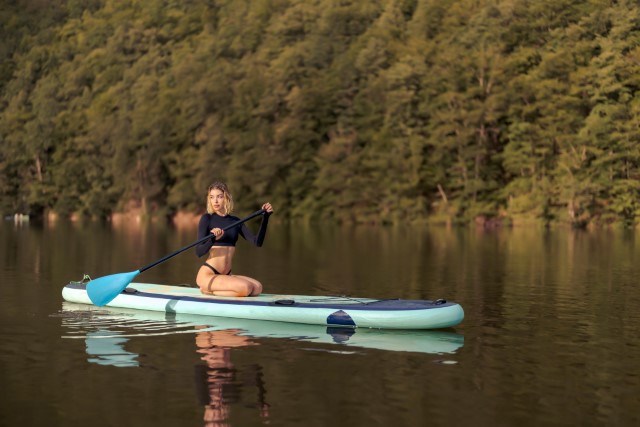
On the other hand, surfboards are ideal for riding waves. The boards perform under extreme water conditions. Likewise, the boards allow you to catch and easily maneuver through waves.
3. Paddle Style
If you own a paddleboard, you might have to use a single-blade paddle to move through the water. You can use the paddle while standing, sitting, or kneeling on the board.
The paddle is handy when you want to gain better control and momentum when riding a wave.
Traditional surfboards only require your hands and feet to push through the water. You must lie flat on the board and paddle using your hands to catch a wave.
Once you catch the wave, you can transition to a standing position.
4. Buoyancy
SUPs have a high buoyancy resulting from their longer, wider, and thicker size.
The high floating capacity adds to the craft’s stability while performing other activities on the board. Additionally, enhanced flotation ensures better gliding on the water surface.
On the other hand, surfboards have a lower buoyancy than paddleboards. With a shorter, narrower, and thinner board size, they submerge more in water and create less resistance while surfing.
The board’s strengthened core helps maintain better maneuverability when riding around waves and helps keep you afloat.
5. Skills
Regarding skill levels, paddleboards require a mastery of balance and basic paddling. As people use standup paddleboards for multiple water activities, you only need to improve your paddling capabilities, especially in calm waters.
Additionally, learning to stand on the board and maintain balance while paddling enhances efficiency.
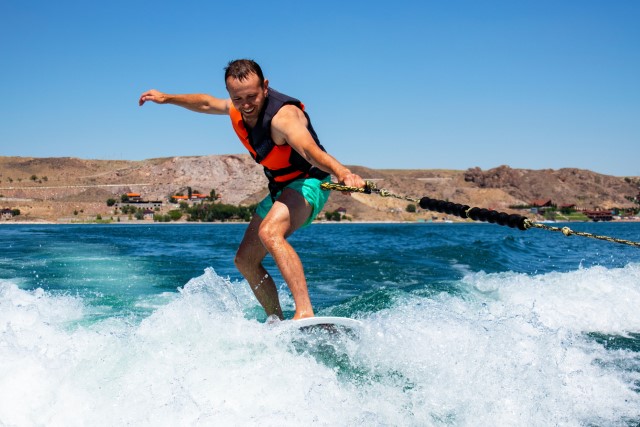
Unlike SUPs, surfboards have a steeper learning curve. You must improve your paddling, maneuvering, and balance, plus enhance your timing and wave selection skills.
Though the board’s slim nature helps improve maneuvering when catching waves, it reduces stability. This can be frustrating for beginners.
6.Board Design
Many SUPs have a rounded nose and square tail, enhancing the board’s stability. The nose also allows the board to glide smoothly on the water’s surface, making it suitable for calmer waters like lakes and rivers.
Surfboards have a pointed nose and tapered tail to improve their hydroplaning. Surfers encounter less resistance while riding waves by smoothly piercing the water’s surface.
Tapered noses and tails also allow you to make quick and critical adjustments when catching and riding waves, enhancing maneuverability and turning.
Paddleboards also have a flatter or lesser rocker than surfboards. A rocker is the curvature or shape of the board from its nose to tail that affects the turning and maneuverability.
Surfboards have a greater rocker curvature making them more agile and responsive while riding waves.
Likewise, rails are the board edges, which affect water displaced efficiency while cutting across the water’s surface. Paddleboards have rounder rails which increase water resistance, improving buoyancy.
On the other hand, surfboards have thinner rails, ideal for smoothly cutting through water and reducing drag, improving the surfing experience.
7.Equipment and Accessories
As previously stated, if you want to rent or buy a paddleboard, the package usually comes with a single-blade paddle.
In addition, a SUP has accessories such as a board leash, a wet suit, an anchor for stationary activities, and a personal floatation device.
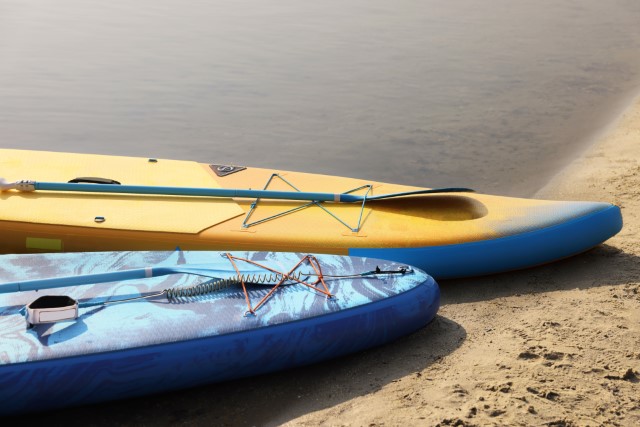
However, surfboard equipment is only the board itself and a leash. Some places also include accessories such as wetsuits and board wax for better grip while surfing.
8.Material
Let’s talk construction and what SUPS are made of. Paddleboards come in two forms: solid and inflatable. Foam makes up the core of solid paddleboards.
Manufacturers layer it with wood veneer or fiberglass before applying an epoxy resin coating. On the other hand, fabric and multiple PVC layers make inflatable SUPs.
Manufacturers create surfboards like standard SUPs, but they only come in solid form. Construction starts with a foam core then manufacturers cover it with a layer of wood veneers or PVC.
Manufacturers can also use fiberglass, carbon fiber, and bamboo to make the board stronger and more durable.
9.Types of Waves
SUP boards are pretty versatile. That means they are ideal for taking out to the lake, river, or ocean for small to medium-rolling waves.
You can also ride higher and stronger waves with more practice, though it might limit your riding control.
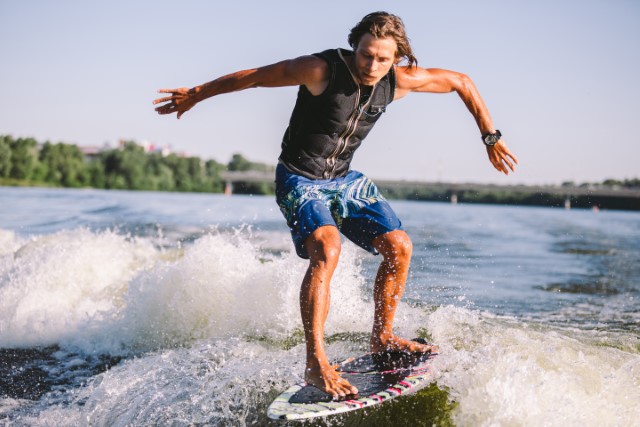
On the other hand, surfboards are ideal for handling medium to powerful waves. The shortboards provide better control, reaction time, maneuvering, and performing tricks on your surfing adventure.
Benefits and Drawbacks of SUP
Now that you have a brief understanding of the differences between the two boards, let us look at some of the advantages and drawbacks of using standup paddleboards.
Pros of SUP
One advantage of buying or renting a SUP is its versatility. The boards are ideal for most water activities, including fishing, leisurely paddling along the shores of a lake or ocean, performing yoga and other water exercises, carrying a pet or child on, and even catching a few small waves.
The board’s design offers perfect stability to try new tricks without too much risk of falling over. Though paddleboards might require some paddling skills, they are accessible to everyone, including the young and elderly.
Additionally, paddleboards are easy to master, especially if you are new to surfing. SUPs are perfect for developing new skills like wave riding, maneuvering, balancing, and paddling.
I recommend starting with a standup paddleboard if you want to get into the surfing scene.
Cons of Surfing on a Stand Up Paddleboard
Though the paddleboard is versatile, you cannot surf all waves. The board’s design cannot handle powerful waves and maneuver through them efficiently.
This can be a challenge, especially in rough currents.
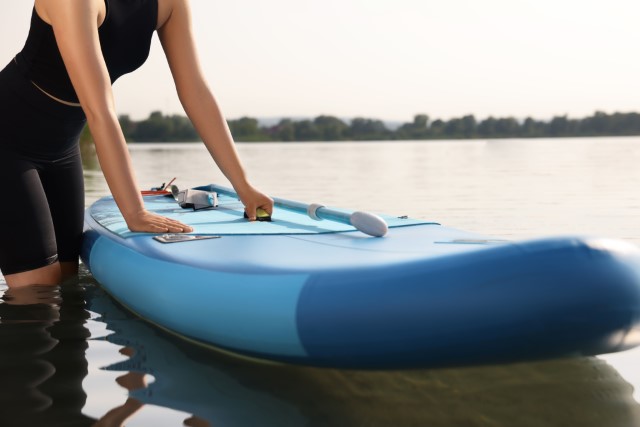
In addition, SUP equipment and accessories can be expensive to buy.
Though the paddles are durable and strong, they are susceptible to damage, especially in rough water conditions. Replacing or repairing the paddle can break the bank.
Though stand-up paddleboards have an easy learning curve overall, learning to adapt to different water conditions is often a challenge for beginners.
Benefits and Drawbacks of Surfboards
On the other hand, you should learn about the benefits and drawbacks of surfboards before buying one.
Pros of Surfboards
Surfboards are an assured way to get the best maneuverability while catching and riding strong waves. The boards provide an easy and smooth surfing experience with the least water resistance or draft.
You can perform more turns and tricks on surfboards than on paddleboards. Surfboards are also an excellent way to master wave selection, balance, and timing for better experiences.
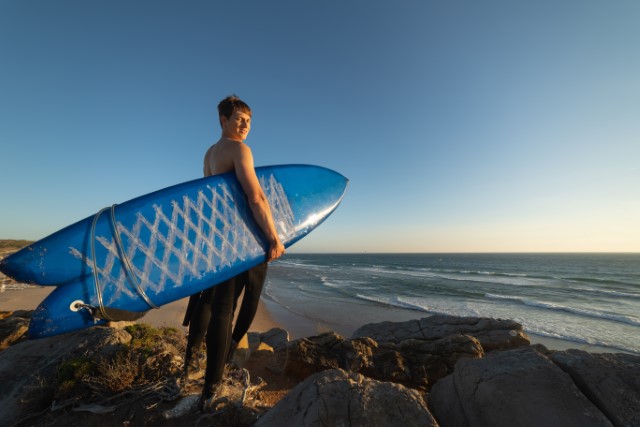
Surfboards are best suited for adrenaline lovers looking to get an exhilarating rush. Most enthusiasts look forward to surfing a green water tunnel.
Paddleboards might not deliver the same thrilling experience.
Cons of Surfboards
A significant drawback of surfboards is wave dependency.
Unlike SUPs, surfboards depend on water currents and waves to propel them. So, the lack of waves can limit your options, ruining the surfing experience.
Likewise, learning how to use a surfboard is harder than SUP. Mastering the surfing techniques requires time and dedication, which can be a problem for most beginners.
Surfboards are also shorter, narrower, and thinner, reducing stability. If you are new to water sports, you may find it difficult to use the board.
Paddling with your arms and feet can increase fatigue and exhaustion.
The Bottom Line
Standup paddle boards (SUP) and surfboards offer unique and immersive experiences for water adventures and explorations. However, you must consider a few things before buying or renting any of the boards.
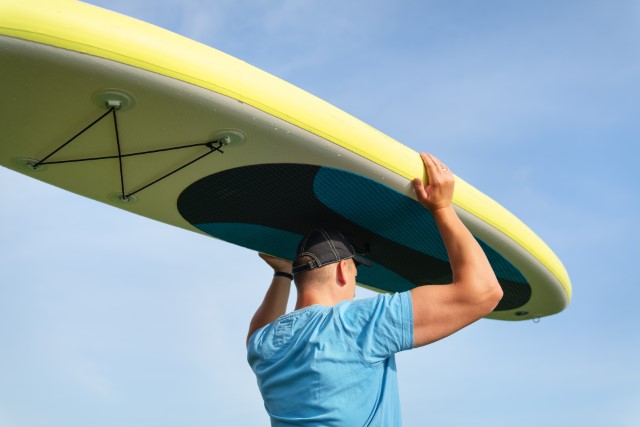
SUP boards provide better stability and buoyancy, holding your weight without submerging. The boards are versatile, requiring a paddle to propel you on the calm water or small to medium waves.
Paddleboards are ideal for most water activities and for enjoying slow outdoor experiences.
On the other hand, surfboards are explicitly designed for thrilling rides on powerful waves and turbulent water currents. You can perform complex maneuvers and tricks using the boards, offering smooth transitions between paddling and surfing.
Before deciding whether you want a SUP or surfboard for your water adventure, consider stability, versatility, maneuverability, functionality, and board design.
I hope this article helps you make the right decision. Have fun catching the waves or just some relaxing time on the water.
Frequently Asked Questions
You probably still have some questions about SUPs, surfboards, and surfing. I’ll go through and answer some of the most frequently asked questions below.
Is standup paddleboarding better than surfing?
SUP and surfing have their perks. However, I suggest starting with a paddle board if you want an easier way to learn a few surfing tricks.
They are more stable and buoyant, and you use a paddle to push through currents, which can be helpful for a beginner.
Can you use SUP boards for surfing?
You can surf using SUPs, but they have limitations. You cannot ride all types of waves and will face maneuverability issues.
However, as long as you have previous experience and good surfing skills, you may still be able to take on waves and currents.
Final Thoughts: SUP vs Surfboard
While there are some similarities between the two, you should be aware of the differences between SUPs and surfboards.
Use the information I’ve provided here to help you figure out whether a SUP or a surfboard is the right choice for you.
You’re still here! Before you take off, check out my Best SUP Brands List (+ brands to definitely avoid).

